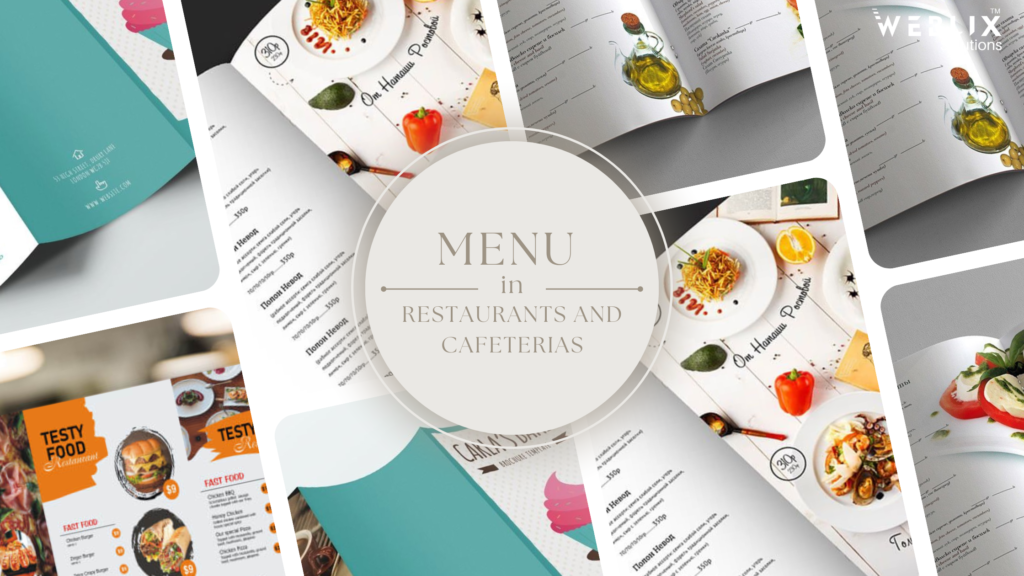A well-designed menu is a cornerstone of any successful restaurant or cafeteria. It serves as a crucial communication tool between the establishment and its patrons, effectively conveying the culinary delights that await them. A menu is more than just a list of dishes; it’s a reflection of the restaurant’s brand, ambiance, and culinary expertise. It should be visually captivating, easy to navigate, and representative of the restaurant’s unique identity and cuisine. The way a menu is designed can significantly impact a customer’s dining experience and their overall perception of the restaurant.
Understanding À La Carte Menus
An à la carte menu offers diners the flexibility to choose from individually priced dishes for each course. This type of menu is particularly appealing as it allows customers to tailor their dining experience to their personal preferences, selecting as much or as little as they desire. The à la carte approach can enhance the dining experience by providing a diverse range of options, ensuring that there is something for everyone. It encourages diners to explore different combinations of appetizers, main courses, and desserts, making each meal a unique culinary adventure.
Top 10 Tips for Menu Design
- Make Sure the Menu is Easy to Read: Utilize clear, legible fonts and avoid clutter to ensure customers can quickly find what they’re looking for.
- Don’t Overwhelm Customers with Choices: A focused selection helps maintain quality and simplifies decision-making for patrons.
- Choose a Cohesive Design: Ensure that the menu design aligns with the restaurant’s overall theme and ambiance for a unified brand experience.
- Keep the Menu to a Single Page: Simplicity is key; a concise menu can make the dining experience less daunting and more enjoyable.
- Stick to a Consistent and Reasonable Pricing Strategy: Prices should be logical and reflective of the quality and portion sizes offered.
- Use Psychology to Your Advantage: Highlight profitable dishes through strategic placement and design elements to guide customer choices.
- Incorporate High-Quality Images: If appropriate, use images to entice customers, but ensure they are professional and appetizing.
- Describe Dishes Vividly: Use appealing language to make dishes sound irresistible.
- Highlight Specials and Signature Dishes: Draw attention to unique offerings that set your restaurant apart.
- Regularly Update the Menu: Keep the menu fresh and exciting by periodically adding new dishes and seasonal items.
Five Actionable Steps for Effective Menu Design
- Analyze Your Sales Reports: Identify which dishes are the best sellers and which ones underperform to make informed decisions about your menu offerings.
- Create a Menu Matrix: Organize menu items by popularity and profitability to focus on promoting the most successful dishes.
- Adjust Menu Item Prices: Regularly review and optimize pricing to ensure it reflects market trends and cost considerations.
- Select Which Dishes to Feature: Highlight top performers and customer favorites prominently on the menu.
- Choose Your Menu Layout Carefully: Ensure a logical flow that guides customers through the menu seamlessly, making their decision-making process easier.
Steps in Meal Planning
- Write Down Days of the Week and Meal Ideas: Plan meals for each day to ensure a balanced and varied diet.
- Find and Collect Recipes: Gather recipes that fit your meal ideas, considering dietary preferences and nutritional needs.
- Add Recipes to a Personal Collection: Organize and save recipes for easy access and future use.
- Finalize the Menu Calendar: Confirm your meal plans and create a schedule.
- Create a Grocery List Based on Chosen Meals: Ensure you have all the necessary ingredients to prepare your planned meals.
Creating the Perfect Daily Specials Menu
- Use Your Environment to Your Advantage: Incorporate locally sourced and seasonal ingredients to keep the menu fresh and relevant.
- Keep Pricing in Line with the Rest of Your Menu: Ensure that daily specials are priced consistently with other menu items.
- Incorporate Seasonal Ingredients: Highlight seasonal produce and ingredients to keep the menu dynamic and appealing.
- Get Your Staff Excited About the Specials: Train your staff to promote and describe specials enthusiastically to customers.
- Promote Specials on Social Media: Use social media platforms to advertise daily specials and attract more customers.
- Use a Menu Template for Daily Specials: Streamline the process by using a consistent template for your specials, making them easy to update and display.
Six Golden Rules for Menu Design
- Right Pricing: Ensure that prices reflect the value and quality of the dishes, and are competitive within the market.
- Choose the Right Material: Select durable and aesthetically pleasing materials for printed menus to enhance the dining experience.
- Design Your Menu Logically: Organize dishes in a way that makes sense, guiding customers through appetizers, mains, and desserts seamlessly.
- Keep the Words Appealing: Use descriptive and enticing language to make dishes sound irresistible.
- Promote Your Signature Dishes: Highlight your best and most unique offerings to attract customers.
- Collect Customer Feedback: Regularly seek and incorporate feedback to continuously improve your menu.
Printed vs. Digital Menus
QR Codes for Menus
- Printed Menus: Ideal for in-house dining, printed menus can enhance the physical dining experience with tactile and visual appeal. They can also be used for distribution to potential customers.
- Digital Menus: Essential for online presence, digital menus are perfect for social media marketing, WhatsApp marketing, and facilitating online orders. Many mobile app delivery services require a digital menu, making them crucial for reaching a broader audience.
The COVID-19 pandemic has popularized the use of QR codes in restaurants. Customers can scan a QR code to access the menu on their smartphones, minimizing physical contact and enhancing convenience. This digital shift makes QR codes as vital as printed menus, offering a modern and hygienic way to present menu options.
How Weblix Designers Can Help
At Weblix, our team of expert designers excels in creating exceptional menu designs that are both visually stunning and highly functional. We offer timely delivery of both print and digital menus, ensuring your restaurant has a cohesive and appealing menu presentation. Our designs not only enhance the customer experience but also help to effectively communicate your brand’s identity and culinary offerings.
By following these tips and strategies, your restaurant can create a menu that not only attracts customers but also enhances their dining experience. For professional menu design services, contact Weblix Solutions. Visit our website to learn more about how we can help you create the perfect menu for your restaurant.




